Project Management Report: ABC Pte Ltd Construction Safety
VerifiedAdded on 2021/04/19
|21
|4233
|35
Project
AI Summary
This project management report examines a construction safety project undertaken by ABC Pte Ltd, focusing on the erection of cantilevered falsework. The report details the project's timing plan, risk assessment processes, and the implementation of safe work procedures (SWP) to minimize worker exposure to hazards. It explores the application of the PDCA (Plan, Do, Check, Act) method, emphasizing the importance of observation, planning, design proposals, and mock-up implementations to ensure safety. The analysis includes a review of risk management frameworks, identifies common construction risks, and evaluates the project's progress towards improving safety standards, cultivating innovation, and boosting productivity. The report also highlights the significance of safety procedures in creating a productive work environment, reducing absenteeism, and lowering compensation claims. The project's goal was to revise falsework erection practices and propose a modular system to enhance safety and efficiency. The report concludes with a self-assessment, action plan, and bibliography.
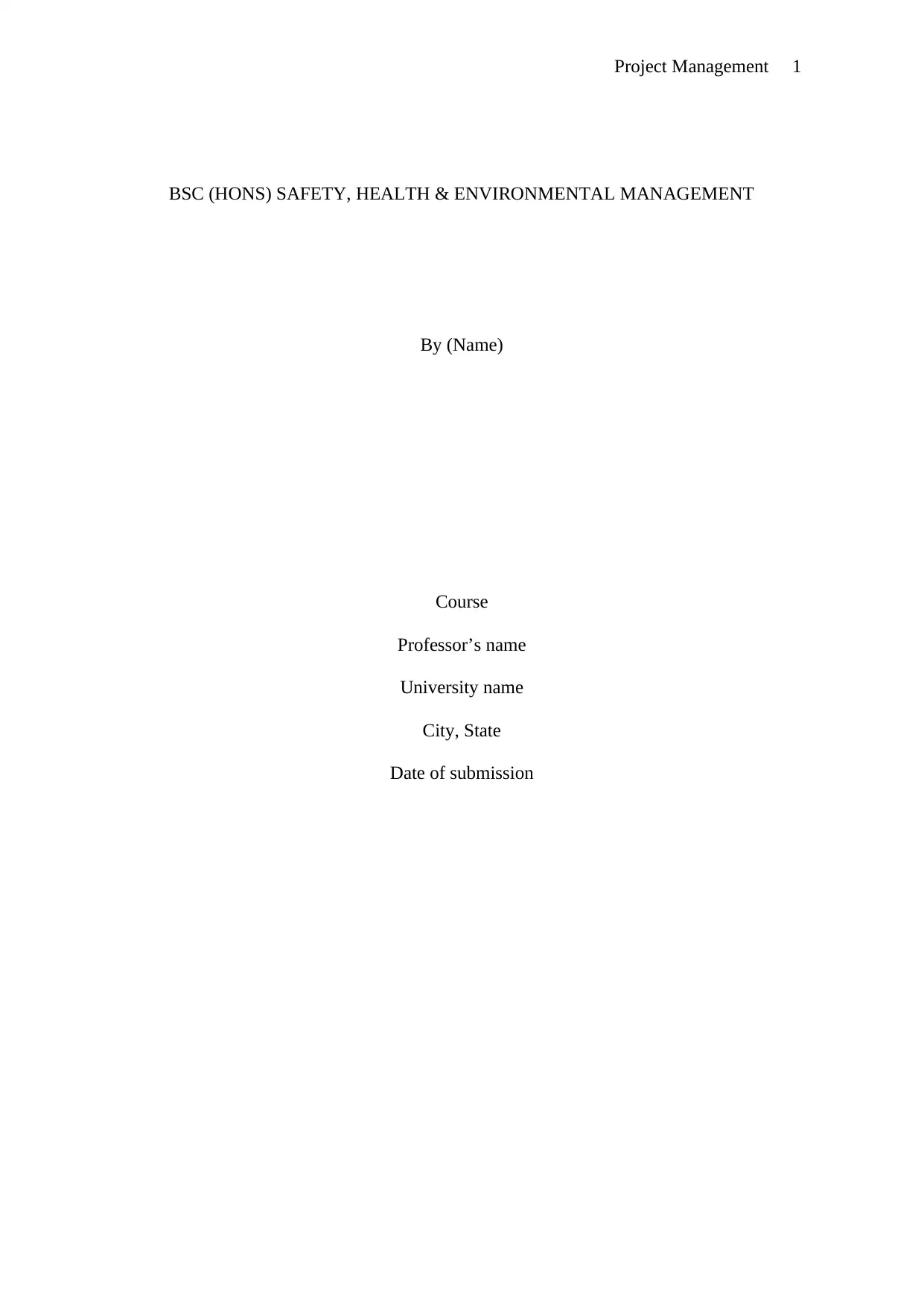
Project Management 1
BSC (HONS) SAFETY, HEALTH & ENVIRONMENTAL MANAGEMENT
By (Name)
Course
Professor’s name
University name
City, State
Date of submission
BSC (HONS) SAFETY, HEALTH & ENVIRONMENTAL MANAGEMENT
By (Name)
Course
Professor’s name
University name
City, State
Date of submission
Paraphrase This Document
Need a fresh take? Get an instant paraphrase of this document with our AI Paraphraser
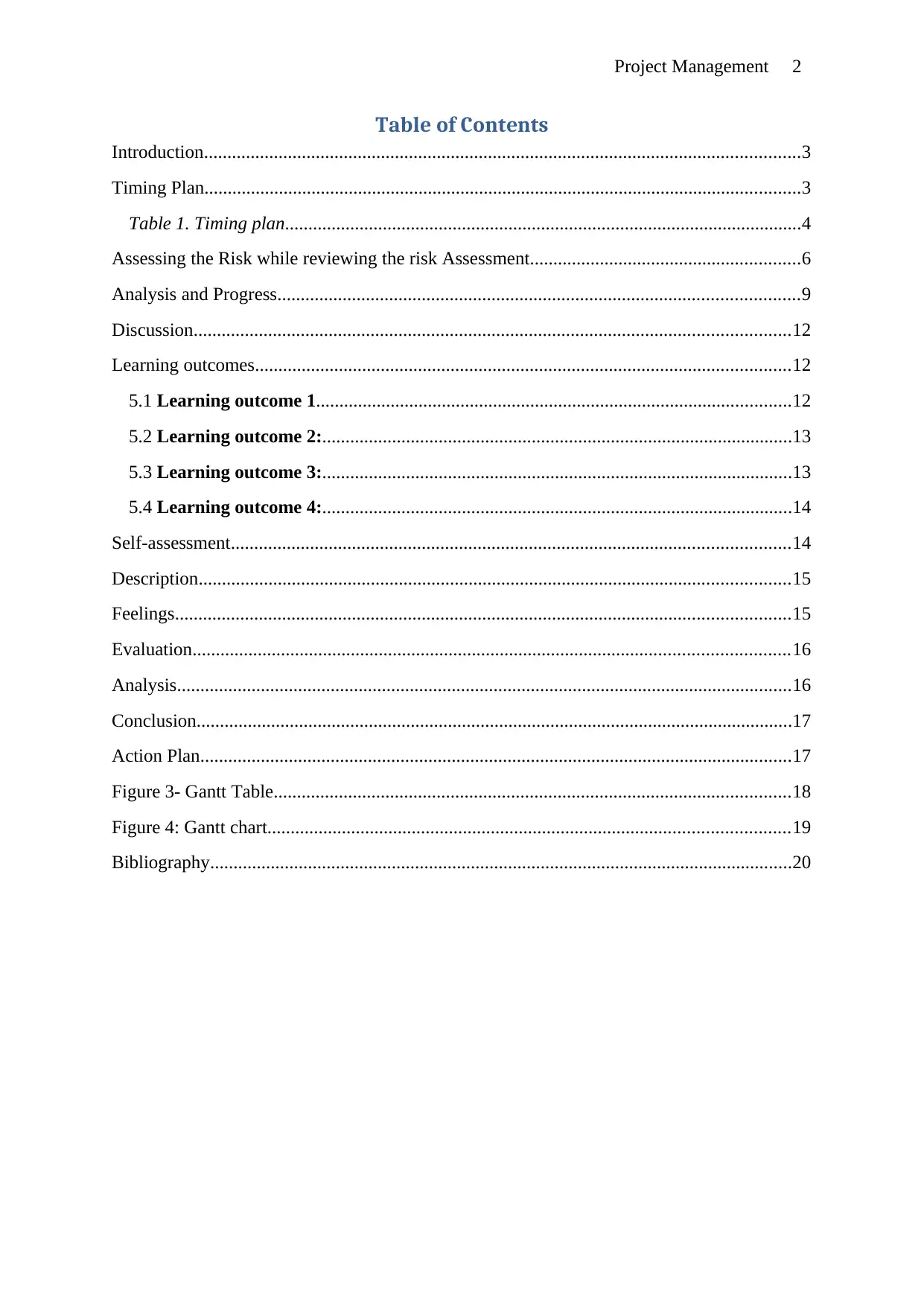
Project Management 2
Table of Contents
Introduction................................................................................................................................3
Timing Plan................................................................................................................................3
Table 1. Timing plan...............................................................................................................4
Assessing the Risk while reviewing the risk Assessment..........................................................6
Analysis and Progress................................................................................................................9
Discussion................................................................................................................................12
Learning outcomes...................................................................................................................12
5.1 Learning outcome 1......................................................................................................12
5.2 Learning outcome 2:.....................................................................................................13
5.3 Learning outcome 3:.....................................................................................................13
5.4 Learning outcome 4:.....................................................................................................14
Self-assessment........................................................................................................................14
Description...............................................................................................................................15
Feelings....................................................................................................................................15
Evaluation................................................................................................................................16
Analysis....................................................................................................................................16
Conclusion................................................................................................................................17
Action Plan...............................................................................................................................17
Figure 3- Gantt Table...............................................................................................................18
Figure 4: Gantt chart................................................................................................................19
Bibliography.............................................................................................................................20
Table of Contents
Introduction................................................................................................................................3
Timing Plan................................................................................................................................3
Table 1. Timing plan...............................................................................................................4
Assessing the Risk while reviewing the risk Assessment..........................................................6
Analysis and Progress................................................................................................................9
Discussion................................................................................................................................12
Learning outcomes...................................................................................................................12
5.1 Learning outcome 1......................................................................................................12
5.2 Learning outcome 2:.....................................................................................................13
5.3 Learning outcome 3:.....................................................................................................13
5.4 Learning outcome 4:.....................................................................................................14
Self-assessment........................................................................................................................14
Description...............................................................................................................................15
Feelings....................................................................................................................................15
Evaluation................................................................................................................................16
Analysis....................................................................................................................................16
Conclusion................................................................................................................................17
Action Plan...............................................................................................................................17
Figure 3- Gantt Table...............................................................................................................18
Figure 4: Gantt chart................................................................................................................19
Bibliography.............................................................................................................................20
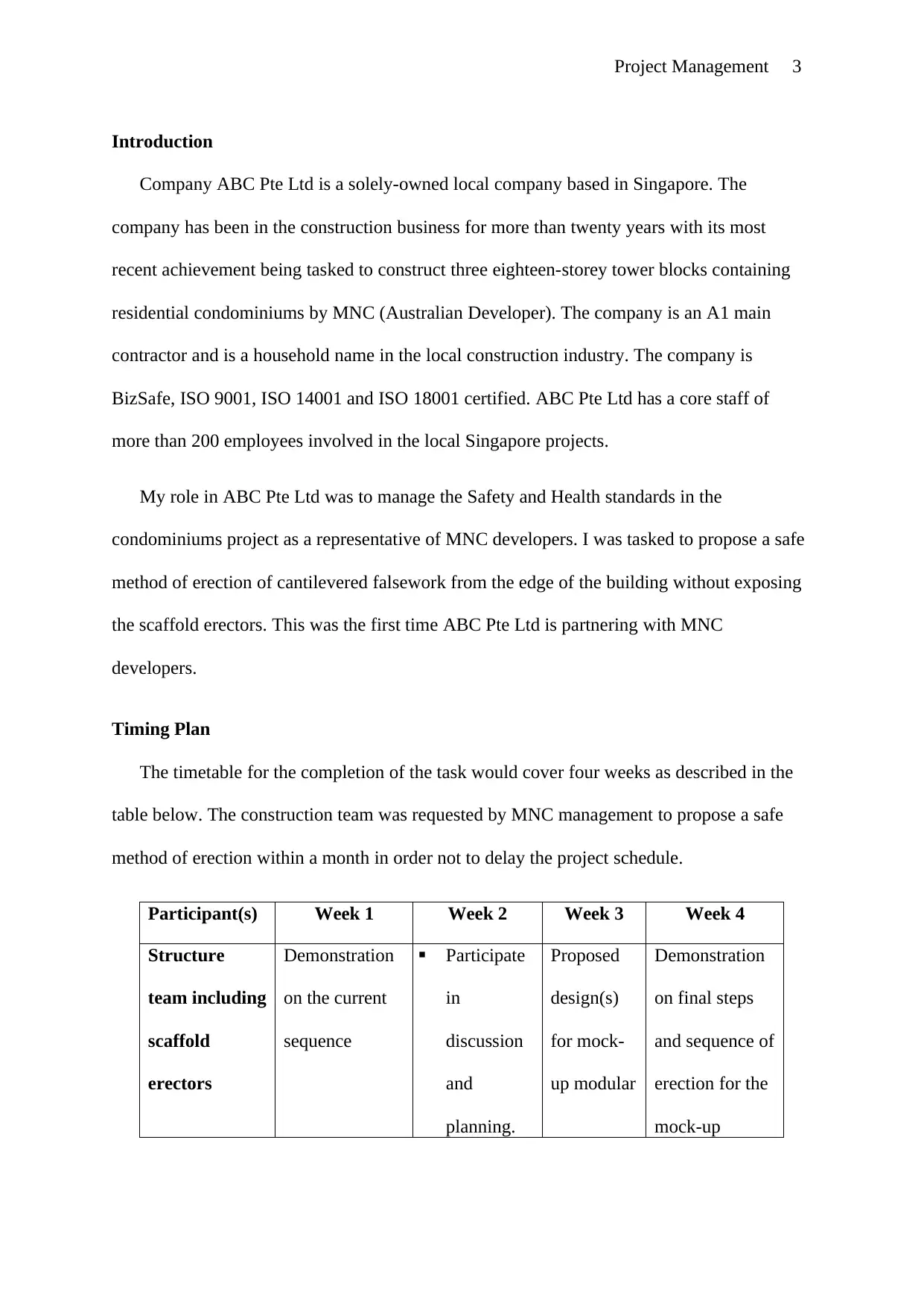
Project Management 3
Introduction
Company ABC Pte Ltd is a solely-owned local company based in Singapore. The
company has been in the construction business for more than twenty years with its most
recent achievement being tasked to construct three eighteen-storey tower blocks containing
residential condominiums by MNC (Australian Developer). The company is an A1 main
contractor and is a household name in the local construction industry. The company is
BizSafe, ISO 9001, ISO 14001 and ISO 18001 certified. ABC Pte Ltd has a core staff of
more than 200 employees involved in the local Singapore projects.
My role in ABC Pte Ltd was to manage the Safety and Health standards in the
condominiums project as a representative of MNC developers. I was tasked to propose a safe
method of erection of cantilevered falsework from the edge of the building without exposing
the scaffold erectors. This was the first time ABC Pte Ltd is partnering with MNC
developers.
Timing Plan
The timetable for the completion of the task would cover four weeks as described in the
table below. The construction team was requested by MNC management to propose a safe
method of erection within a month in order not to delay the project schedule.
Participant(s) Week 1 Week 2 Week 3 Week 4
Structure
team including
scaffold
erectors
Demonstration
on the current
sequence
Participate
in
discussion
and
planning.
Proposed
design(s)
for mock-
up modular
Demonstration
on final steps
and sequence of
erection for the
mock-up
Introduction
Company ABC Pte Ltd is a solely-owned local company based in Singapore. The
company has been in the construction business for more than twenty years with its most
recent achievement being tasked to construct three eighteen-storey tower blocks containing
residential condominiums by MNC (Australian Developer). The company is an A1 main
contractor and is a household name in the local construction industry. The company is
BizSafe, ISO 9001, ISO 14001 and ISO 18001 certified. ABC Pte Ltd has a core staff of
more than 200 employees involved in the local Singapore projects.
My role in ABC Pte Ltd was to manage the Safety and Health standards in the
condominiums project as a representative of MNC developers. I was tasked to propose a safe
method of erection of cantilevered falsework from the edge of the building without exposing
the scaffold erectors. This was the first time ABC Pte Ltd is partnering with MNC
developers.
Timing Plan
The timetable for the completion of the task would cover four weeks as described in the
table below. The construction team was requested by MNC management to propose a safe
method of erection within a month in order not to delay the project schedule.
Participant(s) Week 1 Week 2 Week 3 Week 4
Structure
team including
scaffold
erectors
Demonstration
on the current
sequence
Participate
in
discussion
and
planning.
Proposed
design(s)
for mock-
up modular
Demonstration
on final steps
and sequence of
erection for the
mock-up
⊘ This is a preview!⊘
Do you want full access?
Subscribe today to unlock all pages.

Trusted by 1+ million students worldwide
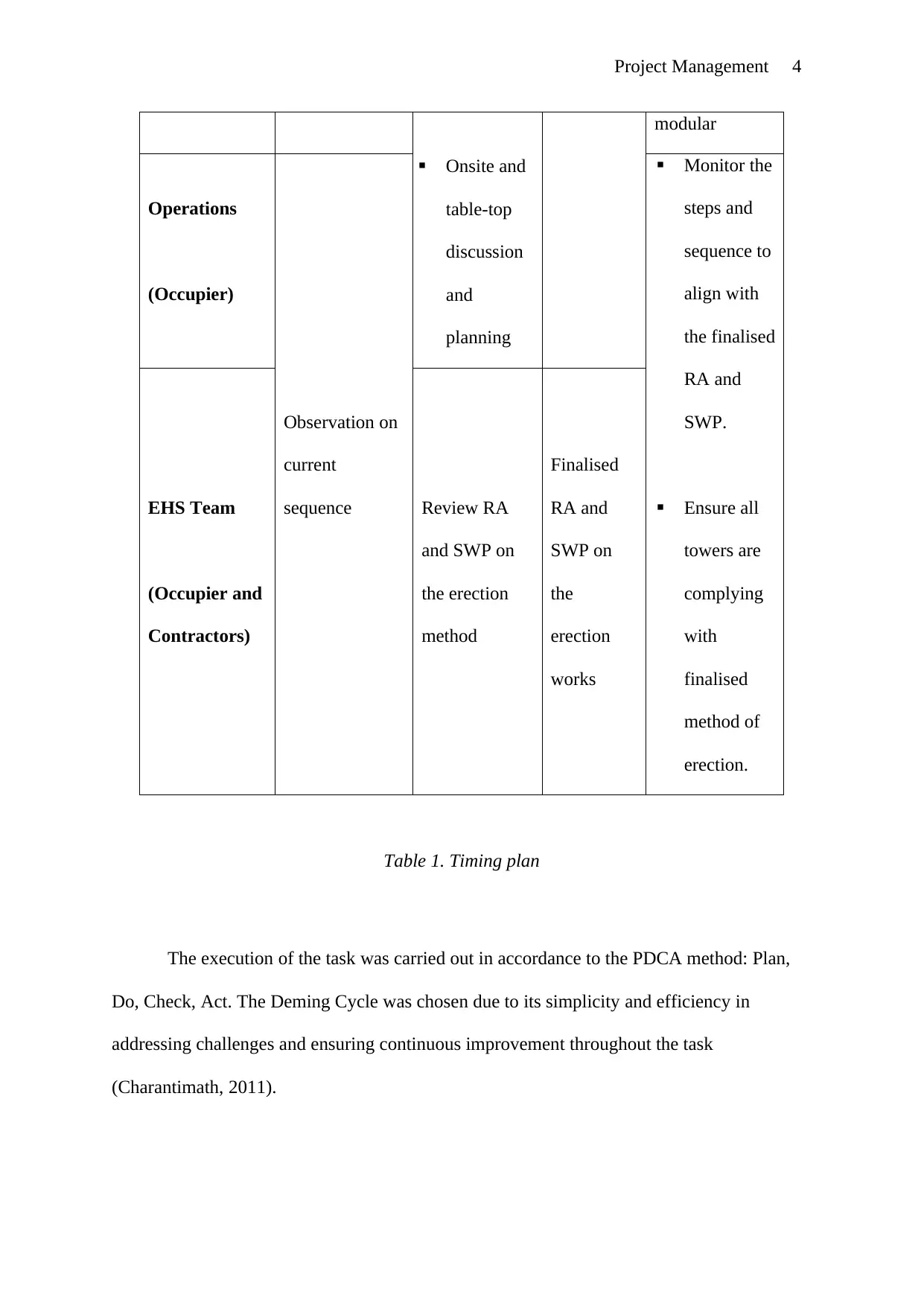
Project Management 4
Onsite and
table-top
discussion
and
planning
modular
Operations
(Occupier)
Observation on
current
sequence
Monitor the
steps and
sequence to
align with
the finalised
RA and
SWP.
Ensure all
towers are
complying
with
finalised
method of
erection.
EHS Team
(Occupier and
Contractors)
Review RA
and SWP on
the erection
method
Finalised
RA and
SWP on
the
erection
works
Table 1. Timing plan
The execution of the task was carried out in accordance to the PDCA method: Plan,
Do, Check, Act. The Deming Cycle was chosen due to its simplicity and efficiency in
addressing challenges and ensuring continuous improvement throughout the task
(Charantimath, 2011).
Onsite and
table-top
discussion
and
planning
modular
Operations
(Occupier)
Observation on
current
sequence
Monitor the
steps and
sequence to
align with
the finalised
RA and
SWP.
Ensure all
towers are
complying
with
finalised
method of
erection.
EHS Team
(Occupier and
Contractors)
Review RA
and SWP on
the erection
method
Finalised
RA and
SWP on
the
erection
works
Table 1. Timing plan
The execution of the task was carried out in accordance to the PDCA method: Plan,
Do, Check, Act. The Deming Cycle was chosen due to its simplicity and efficiency in
addressing challenges and ensuring continuous improvement throughout the task
(Charantimath, 2011).
Paraphrase This Document
Need a fresh take? Get an instant paraphrase of this document with our AI Paraphraser
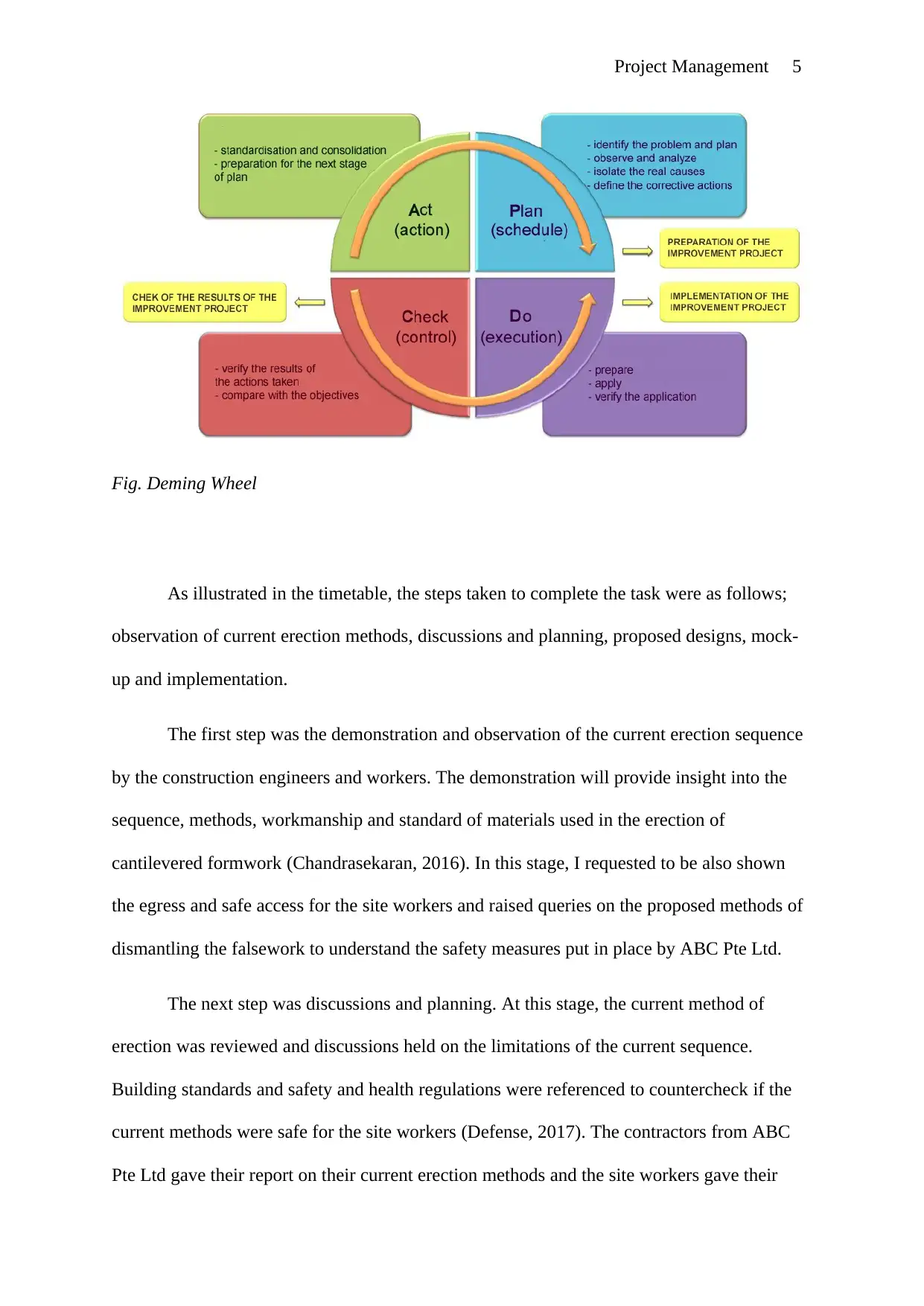
Project Management 5
Fig. Deming Wheel
As illustrated in the timetable, the steps taken to complete the task were as follows;
observation of current erection methods, discussions and planning, proposed designs, mock-
up and implementation.
The first step was the demonstration and observation of the current erection sequence
by the construction engineers and workers. The demonstration will provide insight into the
sequence, methods, workmanship and standard of materials used in the erection of
cantilevered formwork (Chandrasekaran, 2016). In this stage, I requested to be also shown
the egress and safe access for the site workers and raised queries on the proposed methods of
dismantling the falsework to understand the safety measures put in place by ABC Pte Ltd.
The next step was discussions and planning. At this stage, the current method of
erection was reviewed and discussions held on the limitations of the current sequence.
Building standards and safety and health regulations were referenced to countercheck if the
current methods were safe for the site workers (Defense, 2017). The contractors from ABC
Pte Ltd gave their report on their current erection methods and the site workers gave their
Fig. Deming Wheel
As illustrated in the timetable, the steps taken to complete the task were as follows;
observation of current erection methods, discussions and planning, proposed designs, mock-
up and implementation.
The first step was the demonstration and observation of the current erection sequence
by the construction engineers and workers. The demonstration will provide insight into the
sequence, methods, workmanship and standard of materials used in the erection of
cantilevered formwork (Chandrasekaran, 2016). In this stage, I requested to be also shown
the egress and safe access for the site workers and raised queries on the proposed methods of
dismantling the falsework to understand the safety measures put in place by ABC Pte Ltd.
The next step was discussions and planning. At this stage, the current method of
erection was reviewed and discussions held on the limitations of the current sequence.
Building standards and safety and health regulations were referenced to countercheck if the
current methods were safe for the site workers (Defense, 2017). The contractors from ABC
Pte Ltd gave their report on their current erection methods and the site workers gave their
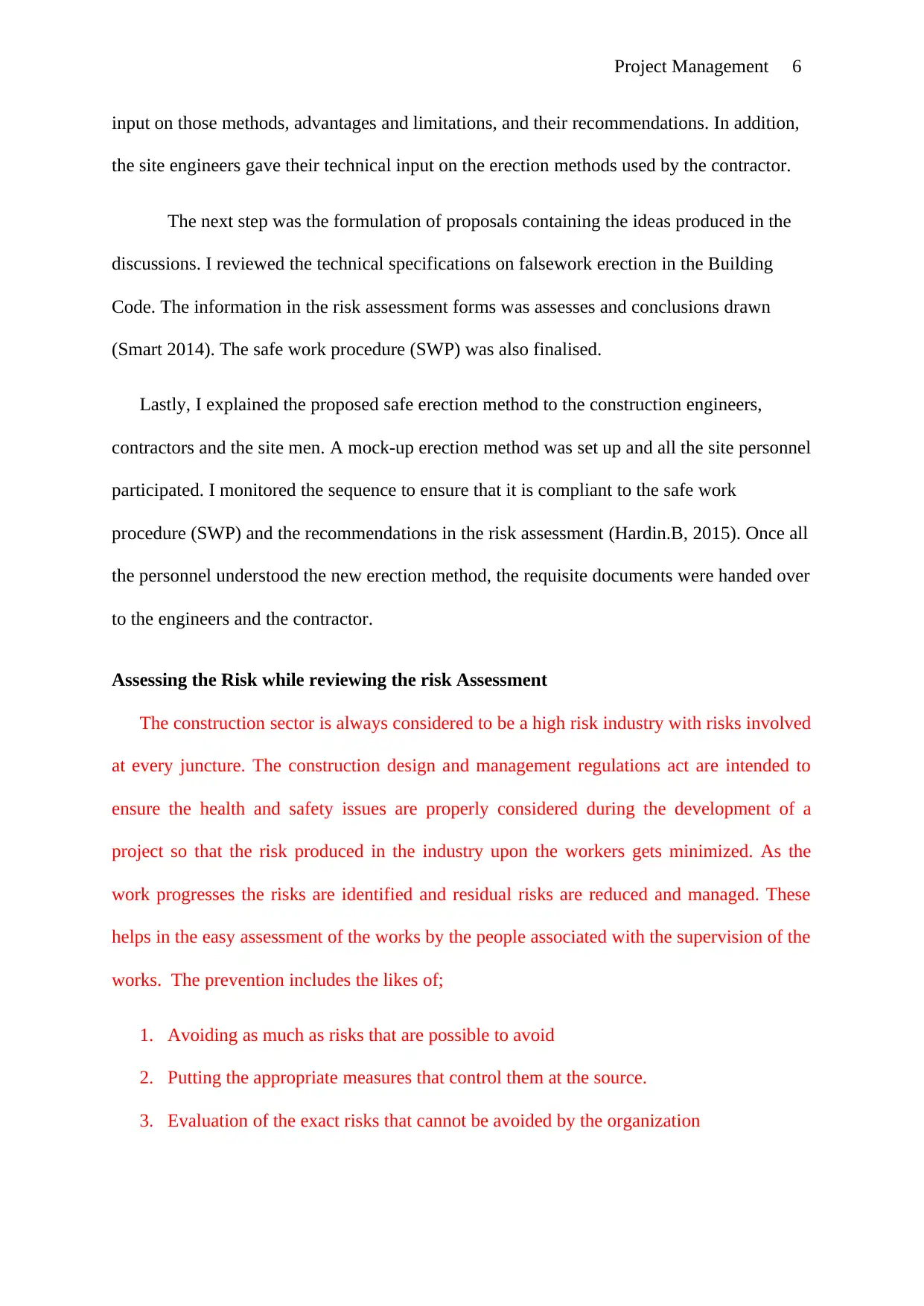
Project Management 6
input on those methods, advantages and limitations, and their recommendations. In addition,
the site engineers gave their technical input on the erection methods used by the contractor.
The next step was the formulation of proposals containing the ideas produced in the
discussions. I reviewed the technical specifications on falsework erection in the Building
Code. The information in the risk assessment forms was assesses and conclusions drawn
(Smart 2014). The safe work procedure (SWP) was also finalised.
Lastly, I explained the proposed safe erection method to the construction engineers,
contractors and the site men. A mock-up erection method was set up and all the site personnel
participated. I monitored the sequence to ensure that it is compliant to the safe work
procedure (SWP) and the recommendations in the risk assessment (Hardin.B, 2015). Once all
the personnel understood the new erection method, the requisite documents were handed over
to the engineers and the contractor.
Assessing the Risk while reviewing the risk Assessment
The construction sector is always considered to be a high risk industry with risks involved
at every juncture. The construction design and management regulations act are intended to
ensure the health and safety issues are properly considered during the development of a
project so that the risk produced in the industry upon the workers gets minimized. As the
work progresses the risks are identified and residual risks are reduced and managed. These
helps in the easy assessment of the works by the people associated with the supervision of the
works. The prevention includes the likes of;
1. Avoiding as much as risks that are possible to avoid
2. Putting the appropriate measures that control them at the source.
3. Evaluation of the exact risks that cannot be avoided by the organization
input on those methods, advantages and limitations, and their recommendations. In addition,
the site engineers gave their technical input on the erection methods used by the contractor.
The next step was the formulation of proposals containing the ideas produced in the
discussions. I reviewed the technical specifications on falsework erection in the Building
Code. The information in the risk assessment forms was assesses and conclusions drawn
(Smart 2014). The safe work procedure (SWP) was also finalised.
Lastly, I explained the proposed safe erection method to the construction engineers,
contractors and the site men. A mock-up erection method was set up and all the site personnel
participated. I monitored the sequence to ensure that it is compliant to the safe work
procedure (SWP) and the recommendations in the risk assessment (Hardin.B, 2015). Once all
the personnel understood the new erection method, the requisite documents were handed over
to the engineers and the contractor.
Assessing the Risk while reviewing the risk Assessment
The construction sector is always considered to be a high risk industry with risks involved
at every juncture. The construction design and management regulations act are intended to
ensure the health and safety issues are properly considered during the development of a
project so that the risk produced in the industry upon the workers gets minimized. As the
work progresses the risks are identified and residual risks are reduced and managed. These
helps in the easy assessment of the works by the people associated with the supervision of the
works. The prevention includes the likes of;
1. Avoiding as much as risks that are possible to avoid
2. Putting the appropriate measures that control them at the source.
3. Evaluation of the exact risks that cannot be avoided by the organization
⊘ This is a preview!⊘
Do you want full access?
Subscribe today to unlock all pages.

Trusted by 1+ million students worldwide
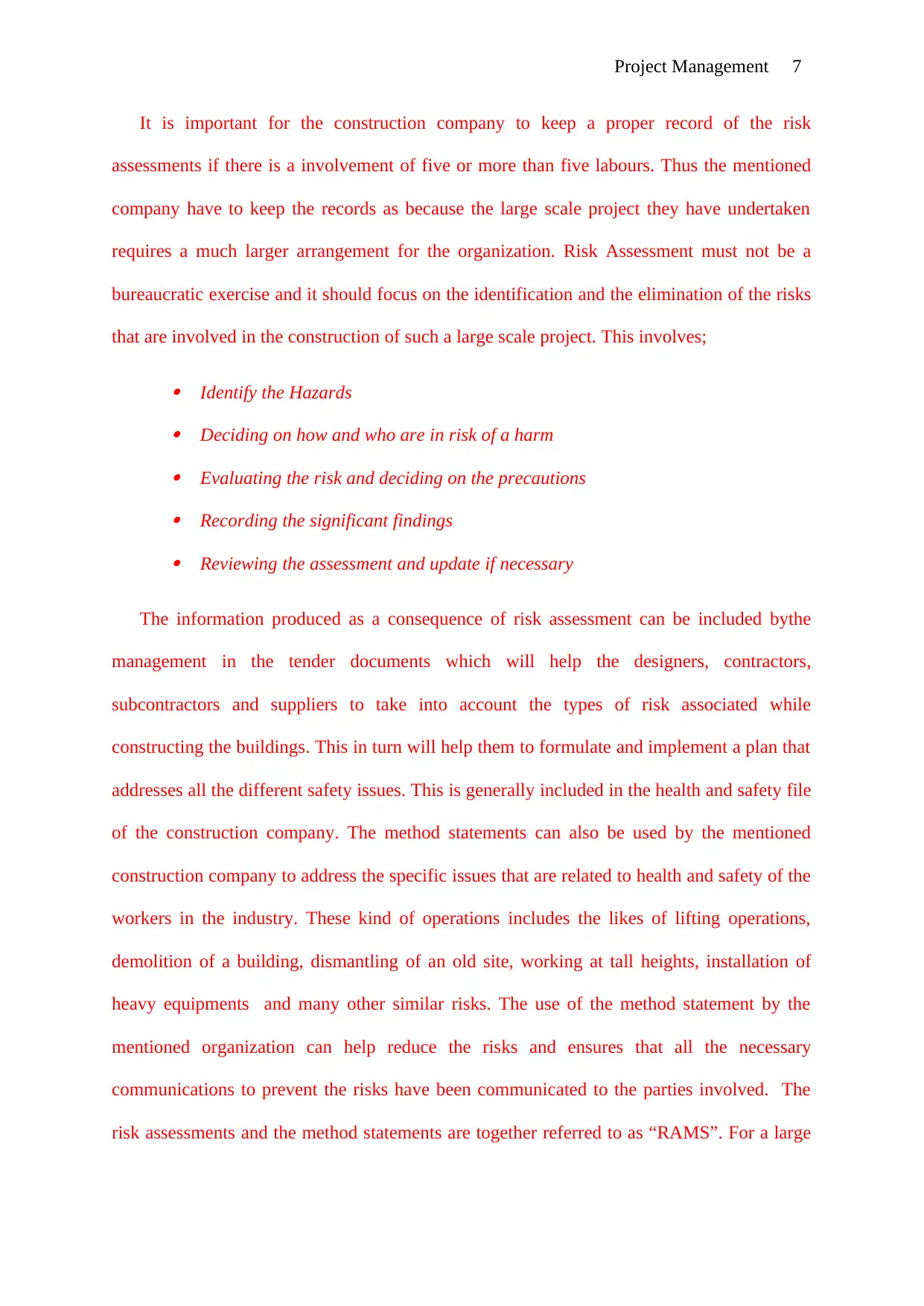
Project Management 7
It is important for the construction company to keep a proper record of the risk
assessments if there is a involvement of five or more than five labours. Thus the mentioned
company have to keep the records as because the large scale project they have undertaken
requires a much larger arrangement for the organization. Risk Assessment must not be a
bureaucratic exercise and it should focus on the identification and the elimination of the risks
that are involved in the construction of such a large scale project. This involves; Identify the Hazards Deciding on how and who are in risk of a harm Evaluating the risk and deciding on the precautions Recording the significant findings Reviewing the assessment and update if necessary
The information produced as a consequence of risk assessment can be included bythe
management in the tender documents which will help the designers, contractors,
subcontractors and suppliers to take into account the types of risk associated while
constructing the buildings. This in turn will help them to formulate and implement a plan that
addresses all the different safety issues. This is generally included in the health and safety file
of the construction company. The method statements can also be used by the mentioned
construction company to address the specific issues that are related to health and safety of the
workers in the industry. These kind of operations includes the likes of lifting operations,
demolition of a building, dismantling of an old site, working at tall heights, installation of
heavy equipments and many other similar risks. The use of the method statement by the
mentioned organization can help reduce the risks and ensures that all the necessary
communications to prevent the risks have been communicated to the parties involved. The
risk assessments and the method statements are together referred to as “RAMS”. For a large
It is important for the construction company to keep a proper record of the risk
assessments if there is a involvement of five or more than five labours. Thus the mentioned
company have to keep the records as because the large scale project they have undertaken
requires a much larger arrangement for the organization. Risk Assessment must not be a
bureaucratic exercise and it should focus on the identification and the elimination of the risks
that are involved in the construction of such a large scale project. This involves; Identify the Hazards Deciding on how and who are in risk of a harm Evaluating the risk and deciding on the precautions Recording the significant findings Reviewing the assessment and update if necessary
The information produced as a consequence of risk assessment can be included bythe
management in the tender documents which will help the designers, contractors,
subcontractors and suppliers to take into account the types of risk associated while
constructing the buildings. This in turn will help them to formulate and implement a plan that
addresses all the different safety issues. This is generally included in the health and safety file
of the construction company. The method statements can also be used by the mentioned
construction company to address the specific issues that are related to health and safety of the
workers in the industry. These kind of operations includes the likes of lifting operations,
demolition of a building, dismantling of an old site, working at tall heights, installation of
heavy equipments and many other similar risks. The use of the method statement by the
mentioned organization can help reduce the risks and ensures that all the necessary
communications to prevent the risks have been communicated to the parties involved. The
risk assessments and the method statements are together referred to as “RAMS”. For a large
Paraphrase This Document
Need a fresh take? Get an instant paraphrase of this document with our AI Paraphraser
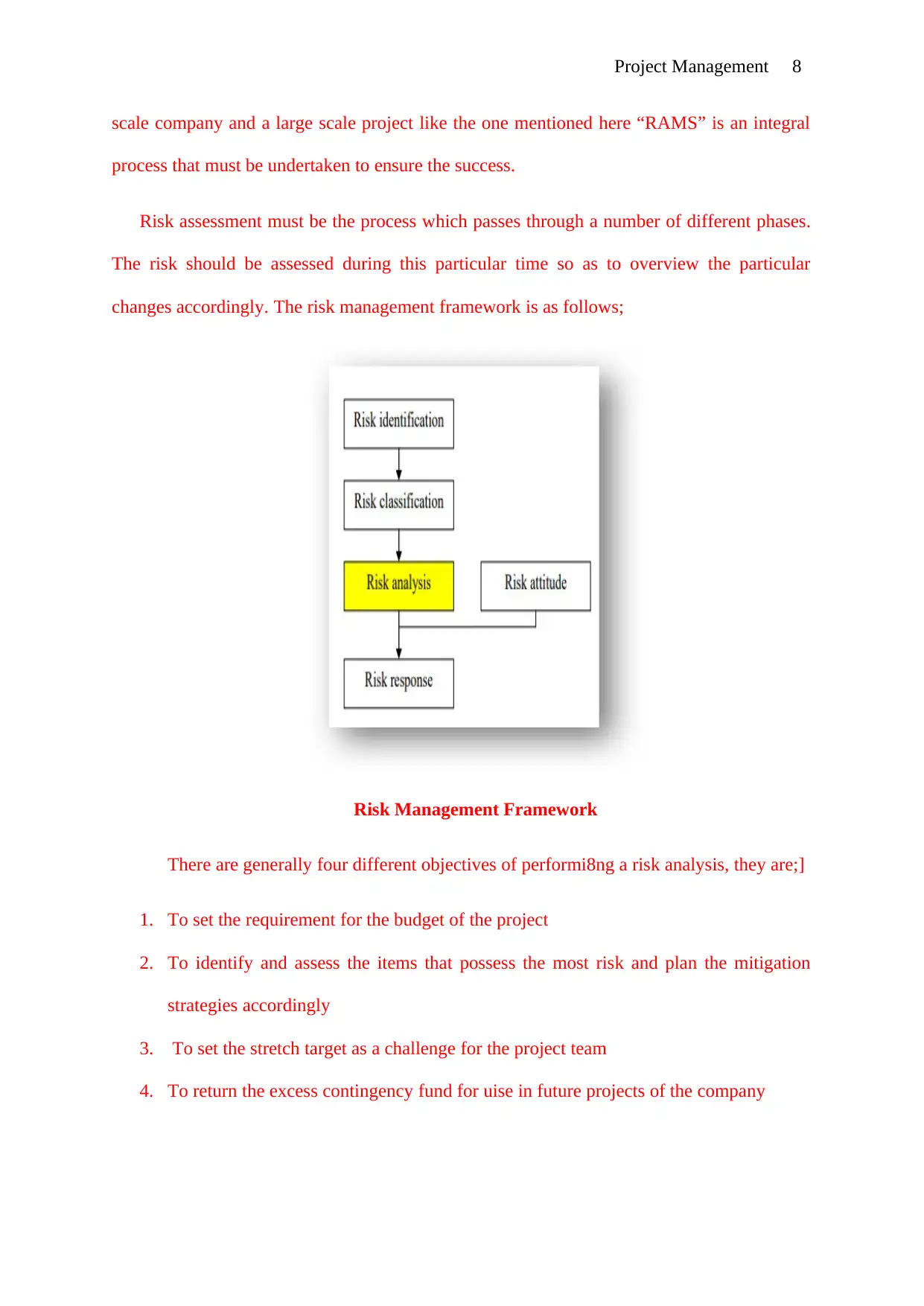
Project Management 8
scale company and a large scale project like the one mentioned here “RAMS” is an integral
process that must be undertaken to ensure the success.
Risk assessment must be the process which passes through a number of different phases.
The risk should be assessed during this particular time so as to overview the particular
changes accordingly. The risk management framework is as follows;
Risk Management Framework
There are generally four different objectives of performi8ng a risk analysis, they are;]
1. To set the requirement for the budget of the project
2. To identify and assess the items that possess the most risk and plan the mitigation
strategies accordingly
3. To set the stretch target as a challenge for the project team
4. To return the excess contingency fund for uise in future projects of the company
scale company and a large scale project like the one mentioned here “RAMS” is an integral
process that must be undertaken to ensure the success.
Risk assessment must be the process which passes through a number of different phases.
The risk should be assessed during this particular time so as to overview the particular
changes accordingly. The risk management framework is as follows;
Risk Management Framework
There are generally four different objectives of performi8ng a risk analysis, they are;]
1. To set the requirement for the budget of the project
2. To identify and assess the items that possess the most risk and plan the mitigation
strategies accordingly
3. To set the stretch target as a challenge for the project team
4. To return the excess contingency fund for uise in future projects of the company
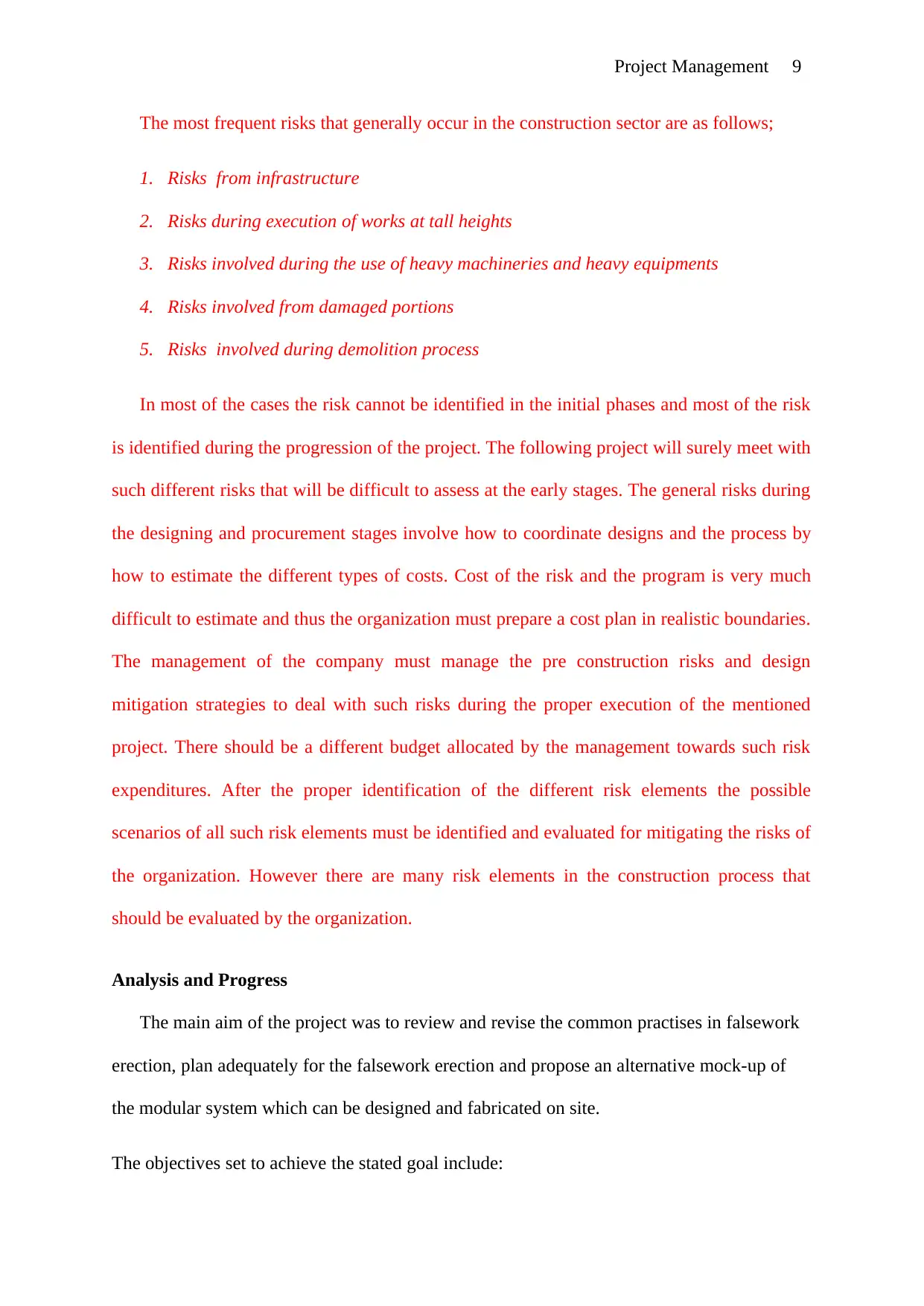
Project Management 9
The most frequent risks that generally occur in the construction sector are as follows;
1. Risks from infrastructure
2. Risks during execution of works at tall heights
3. Risks involved during the use of heavy machineries and heavy equipments
4. Risks involved from damaged portions
5. Risks involved during demolition process
In most of the cases the risk cannot be identified in the initial phases and most of the risk
is identified during the progression of the project. The following project will surely meet with
such different risks that will be difficult to assess at the early stages. The general risks during
the designing and procurement stages involve how to coordinate designs and the process by
how to estimate the different types of costs. Cost of the risk and the program is very much
difficult to estimate and thus the organization must prepare a cost plan in realistic boundaries.
The management of the company must manage the pre construction risks and design
mitigation strategies to deal with such risks during the proper execution of the mentioned
project. There should be a different budget allocated by the management towards such risk
expenditures. After the proper identification of the different risk elements the possible
scenarios of all such risk elements must be identified and evaluated for mitigating the risks of
the organization. However there are many risk elements in the construction process that
should be evaluated by the organization.
Analysis and Progress
The main aim of the project was to review and revise the common practises in falsework
erection, plan adequately for the falsework erection and propose an alternative mock-up of
the modular system which can be designed and fabricated on site.
The objectives set to achieve the stated goal include:
The most frequent risks that generally occur in the construction sector are as follows;
1. Risks from infrastructure
2. Risks during execution of works at tall heights
3. Risks involved during the use of heavy machineries and heavy equipments
4. Risks involved from damaged portions
5. Risks involved during demolition process
In most of the cases the risk cannot be identified in the initial phases and most of the risk
is identified during the progression of the project. The following project will surely meet with
such different risks that will be difficult to assess at the early stages. The general risks during
the designing and procurement stages involve how to coordinate designs and the process by
how to estimate the different types of costs. Cost of the risk and the program is very much
difficult to estimate and thus the organization must prepare a cost plan in realistic boundaries.
The management of the company must manage the pre construction risks and design
mitigation strategies to deal with such risks during the proper execution of the mentioned
project. There should be a different budget allocated by the management towards such risk
expenditures. After the proper identification of the different risk elements the possible
scenarios of all such risk elements must be identified and evaluated for mitigating the risks of
the organization. However there are many risk elements in the construction process that
should be evaluated by the organization.
Analysis and Progress
The main aim of the project was to review and revise the common practises in falsework
erection, plan adequately for the falsework erection and propose an alternative mock-up of
the modular system which can be designed and fabricated on site.
The objectives set to achieve the stated goal include:
⊘ This is a preview!⊘
Do you want full access?
Subscribe today to unlock all pages.

Trusted by 1+ million students worldwide
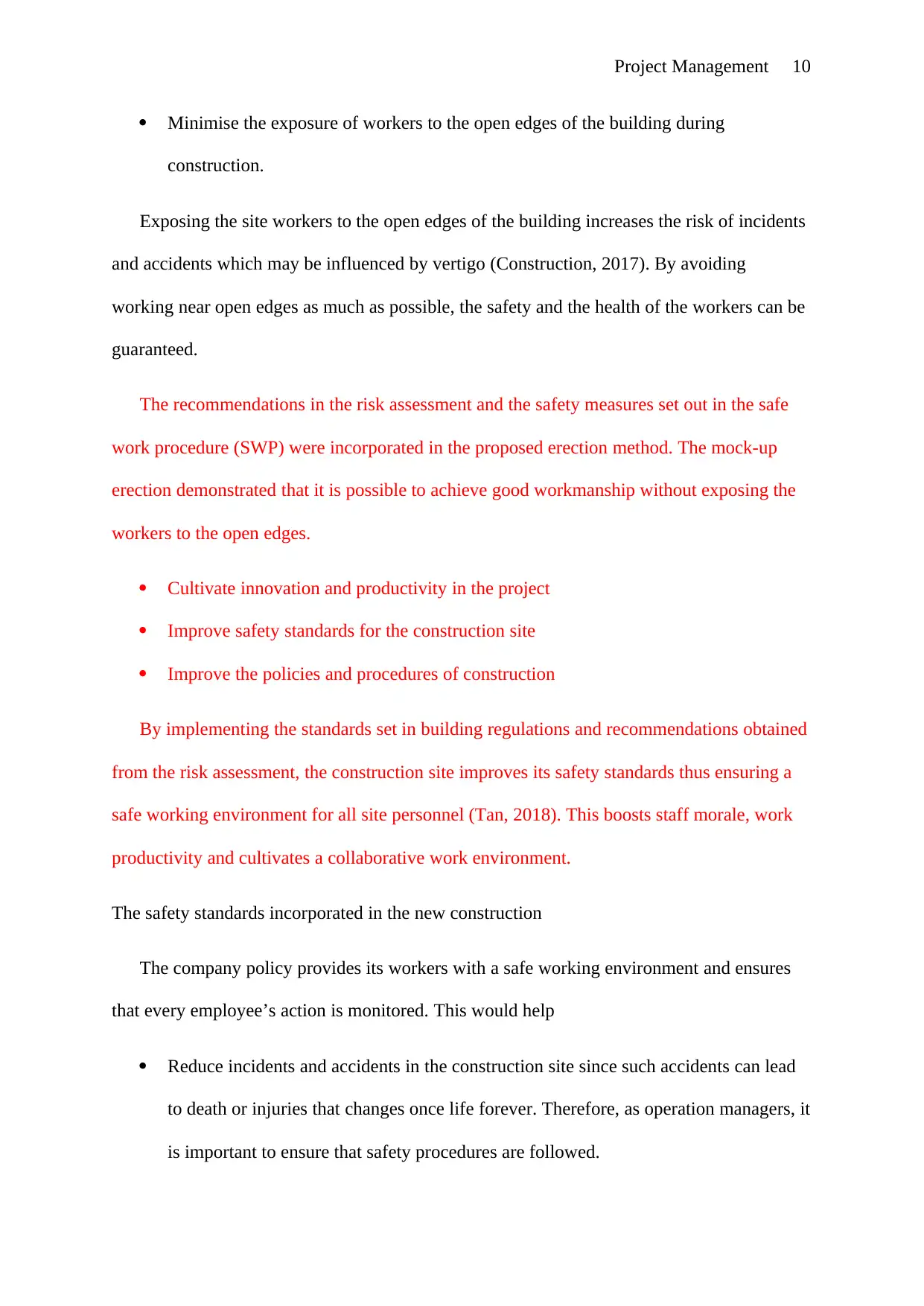
Project Management 10
Minimise the exposure of workers to the open edges of the building during
construction.
Exposing the site workers to the open edges of the building increases the risk of incidents
and accidents which may be influenced by vertigo (Construction, 2017). By avoiding
working near open edges as much as possible, the safety and the health of the workers can be
guaranteed.
The recommendations in the risk assessment and the safety measures set out in the safe
work procedure (SWP) were incorporated in the proposed erection method. The mock-up
erection demonstrated that it is possible to achieve good workmanship without exposing the
workers to the open edges.
Cultivate innovation and productivity in the project
Improve safety standards for the construction site
Improve the policies and procedures of construction
By implementing the standards set in building regulations and recommendations obtained
from the risk assessment, the construction site improves its safety standards thus ensuring a
safe working environment for all site personnel (Tan, 2018). This boosts staff morale, work
productivity and cultivates a collaborative work environment.
The safety standards incorporated in the new construction
The company policy provides its workers with a safe working environment and ensures
that every employee’s action is monitored. This would help
Reduce incidents and accidents in the construction site since such accidents can lead
to death or injuries that changes once life forever. Therefore, as operation managers, it
is important to ensure that safety procedures are followed.
Minimise the exposure of workers to the open edges of the building during
construction.
Exposing the site workers to the open edges of the building increases the risk of incidents
and accidents which may be influenced by vertigo (Construction, 2017). By avoiding
working near open edges as much as possible, the safety and the health of the workers can be
guaranteed.
The recommendations in the risk assessment and the safety measures set out in the safe
work procedure (SWP) were incorporated in the proposed erection method. The mock-up
erection demonstrated that it is possible to achieve good workmanship without exposing the
workers to the open edges.
Cultivate innovation and productivity in the project
Improve safety standards for the construction site
Improve the policies and procedures of construction
By implementing the standards set in building regulations and recommendations obtained
from the risk assessment, the construction site improves its safety standards thus ensuring a
safe working environment for all site personnel (Tan, 2018). This boosts staff morale, work
productivity and cultivates a collaborative work environment.
The safety standards incorporated in the new construction
The company policy provides its workers with a safe working environment and ensures
that every employee’s action is monitored. This would help
Reduce incidents and accidents in the construction site since such accidents can lead
to death or injuries that changes once life forever. Therefore, as operation managers, it
is important to ensure that safety procedures are followed.
Paraphrase This Document
Need a fresh take? Get an instant paraphrase of this document with our AI Paraphraser
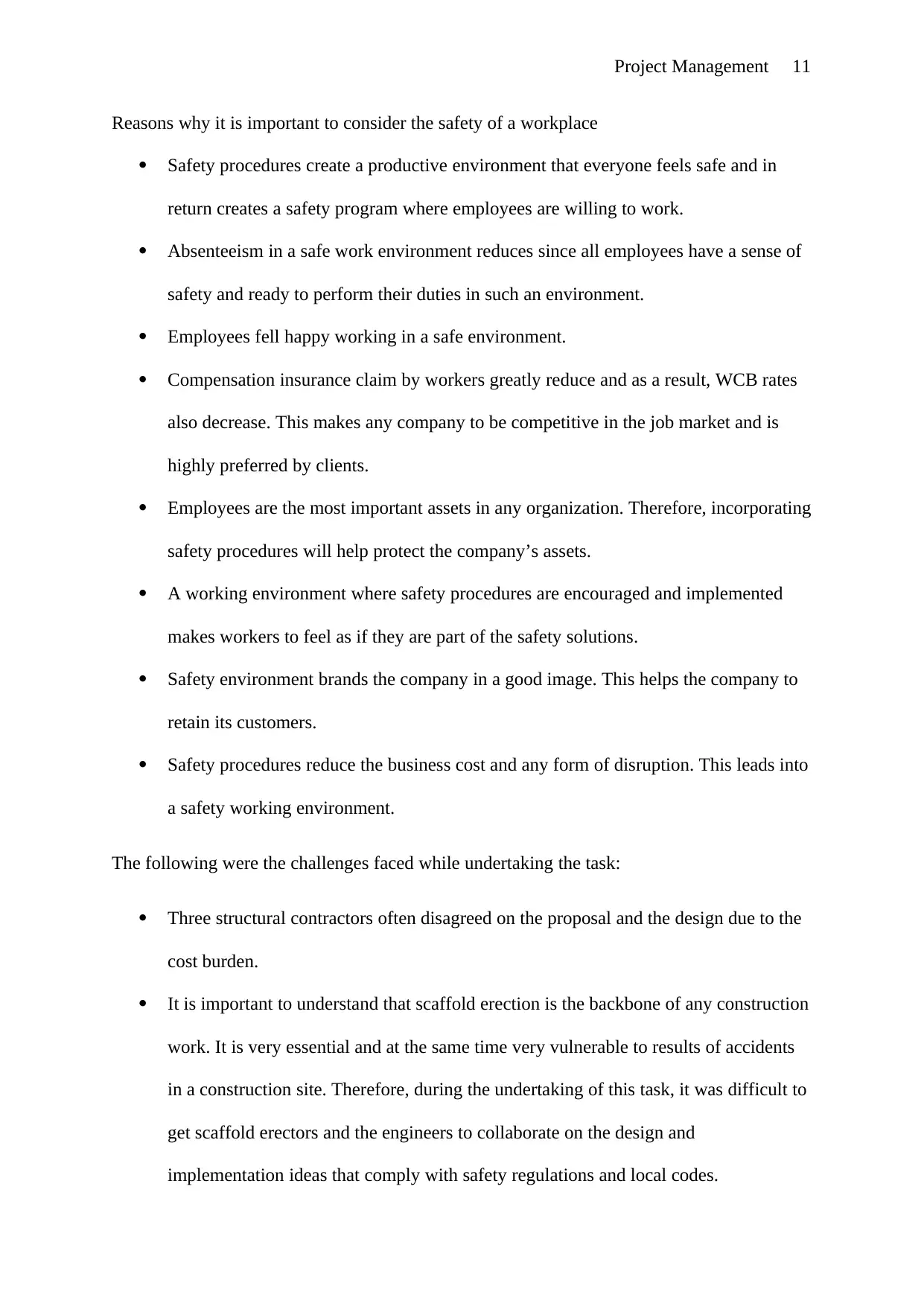
Project Management 11
Reasons why it is important to consider the safety of a workplace
Safety procedures create a productive environment that everyone feels safe and in
return creates a safety program where employees are willing to work.
Absenteeism in a safe work environment reduces since all employees have a sense of
safety and ready to perform their duties in such an environment.
Employees fell happy working in a safe environment.
Compensation insurance claim by workers greatly reduce and as a result, WCB rates
also decrease. This makes any company to be competitive in the job market and is
highly preferred by clients.
Employees are the most important assets in any organization. Therefore, incorporating
safety procedures will help protect the company’s assets.
A working environment where safety procedures are encouraged and implemented
makes workers to feel as if they are part of the safety solutions.
Safety environment brands the company in a good image. This helps the company to
retain its customers.
Safety procedures reduce the business cost and any form of disruption. This leads into
a safety working environment.
The following were the challenges faced while undertaking the task:
Three structural contractors often disagreed on the proposal and the design due to the
cost burden.
It is important to understand that scaffold erection is the backbone of any construction
work. It is very essential and at the same time very vulnerable to results of accidents
in a construction site. Therefore, during the undertaking of this task, it was difficult to
get scaffold erectors and the engineers to collaborate on the design and
implementation ideas that comply with safety regulations and local codes.
Reasons why it is important to consider the safety of a workplace
Safety procedures create a productive environment that everyone feels safe and in
return creates a safety program where employees are willing to work.
Absenteeism in a safe work environment reduces since all employees have a sense of
safety and ready to perform their duties in such an environment.
Employees fell happy working in a safe environment.
Compensation insurance claim by workers greatly reduce and as a result, WCB rates
also decrease. This makes any company to be competitive in the job market and is
highly preferred by clients.
Employees are the most important assets in any organization. Therefore, incorporating
safety procedures will help protect the company’s assets.
A working environment where safety procedures are encouraged and implemented
makes workers to feel as if they are part of the safety solutions.
Safety environment brands the company in a good image. This helps the company to
retain its customers.
Safety procedures reduce the business cost and any form of disruption. This leads into
a safety working environment.
The following were the challenges faced while undertaking the task:
Three structural contractors often disagreed on the proposal and the design due to the
cost burden.
It is important to understand that scaffold erection is the backbone of any construction
work. It is very essential and at the same time very vulnerable to results of accidents
in a construction site. Therefore, during the undertaking of this task, it was difficult to
get scaffold erectors and the engineers to collaborate on the design and
implementation ideas that comply with safety regulations and local codes.
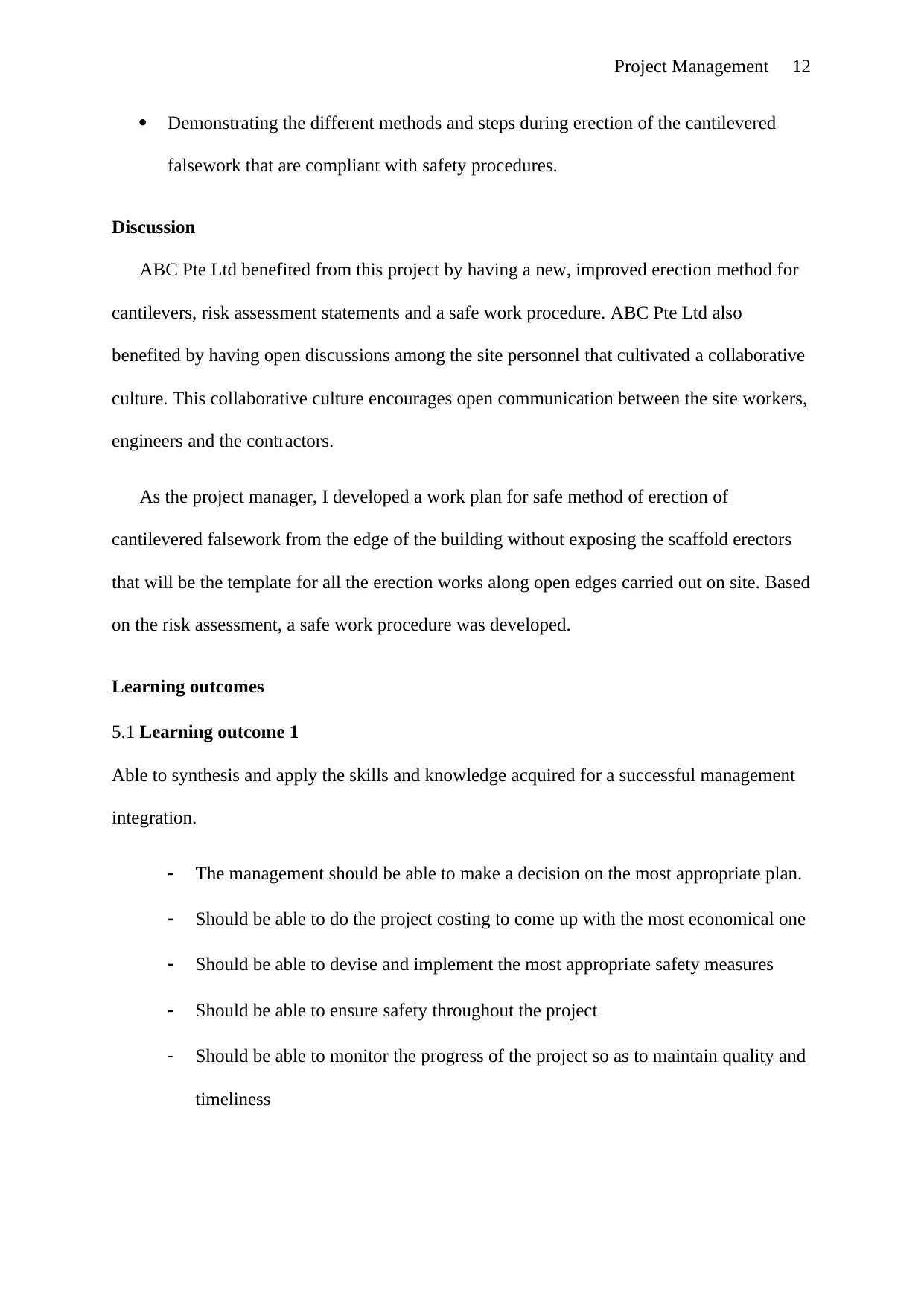
Project Management 12
Demonstrating the different methods and steps during erection of the cantilevered
falsework that are compliant with safety procedures.
Discussion
ABC Pte Ltd benefited from this project by having a new, improved erection method for
cantilevers, risk assessment statements and a safe work procedure. ABC Pte Ltd also
benefited by having open discussions among the site personnel that cultivated a collaborative
culture. This collaborative culture encourages open communication between the site workers,
engineers and the contractors.
As the project manager, I developed a work plan for safe method of erection of
cantilevered falsework from the edge of the building without exposing the scaffold erectors
that will be the template for all the erection works along open edges carried out on site. Based
on the risk assessment, a safe work procedure was developed.
Learning outcomes
5.1 Learning outcome 1
Able to synthesis and apply the skills and knowledge acquired for a successful management
integration.
- The management should be able to make a decision on the most appropriate plan.
- Should be able to do the project costing to come up with the most economical one
- Should be able to devise and implement the most appropriate safety measures
- Should be able to ensure safety throughout the project
- Should be able to monitor the progress of the project so as to maintain quality and
timeliness
Demonstrating the different methods and steps during erection of the cantilevered
falsework that are compliant with safety procedures.
Discussion
ABC Pte Ltd benefited from this project by having a new, improved erection method for
cantilevers, risk assessment statements and a safe work procedure. ABC Pte Ltd also
benefited by having open discussions among the site personnel that cultivated a collaborative
culture. This collaborative culture encourages open communication between the site workers,
engineers and the contractors.
As the project manager, I developed a work plan for safe method of erection of
cantilevered falsework from the edge of the building without exposing the scaffold erectors
that will be the template for all the erection works along open edges carried out on site. Based
on the risk assessment, a safe work procedure was developed.
Learning outcomes
5.1 Learning outcome 1
Able to synthesis and apply the skills and knowledge acquired for a successful management
integration.
- The management should be able to make a decision on the most appropriate plan.
- Should be able to do the project costing to come up with the most economical one
- Should be able to devise and implement the most appropriate safety measures
- Should be able to ensure safety throughout the project
- Should be able to monitor the progress of the project so as to maintain quality and
timeliness
⊘ This is a preview!⊘
Do you want full access?
Subscribe today to unlock all pages.

Trusted by 1+ million students worldwide
1 out of 21
Your All-in-One AI-Powered Toolkit for Academic Success.
+13062052269
info@desklib.com
Available 24*7 on WhatsApp / Email
![[object Object]](/_next/static/media/star-bottom.7253800d.svg)
Unlock your academic potential
Copyright © 2020–2025 A2Z Services. All Rights Reserved. Developed and managed by ZUCOL.